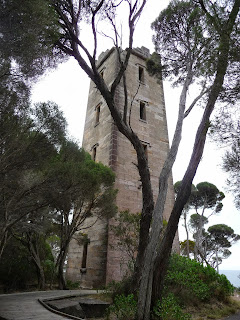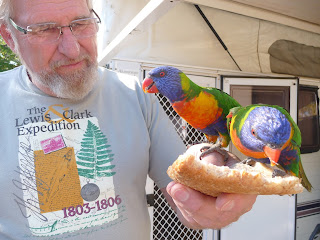 Leaving Goulburn early on Saturday (Australian Election Day) we drove to Windellama about 40 kms south on our quest to find and photograph another lone soldier's grave. This 18yo soldier had been buried in the grounds of a remote Roman Catholic church in 1942. The church and surrounds were abandoned and are now derelict and overgrown. As it is situated on a local farmer's property and it was only with the help of a local historian who arranged our visit to the farm and drove us in a 4WD following the farmer a considerable distance over very rough ground that we were able to achieve our aim. This photo shows the three men surrounding the grave. The photo of the grave plus the GPS reading we took will eventually be attached to the soldier's details on the website of the Commonwealth War Graves Commission.
Leaving Goulburn early on Saturday (Australian Election Day) we drove to Windellama about 40 kms south on our quest to find and photograph another lone soldier's grave. This 18yo soldier had been buried in the grounds of a remote Roman Catholic church in 1942. The church and surrounds were abandoned and are now derelict and overgrown. As it is situated on a local farmer's property and it was only with the help of a local historian who arranged our visit to the farm and drove us in a 4WD following the farmer a considerable distance over very rough ground that we were able to achieve our aim. This photo shows the three men surrounding the grave. The photo of the grave plus the GPS reading we took will eventually be attached to the soldier's details on the website of the Commonwealth War Graves Commission.It wasn't till early afternoon that we were able to continue our journey and so came to Moruya - a beautiful little town on the coast and while we would have loved to stay longer than overnight, we continued on next morning travelling down the coast road (the Princes Highway) and stopped at the Bega Cheese Centre. We had visited here 2011 and morning coffee seemed to be a good excuse for another visit. We took the opportunity to stock up on their wonderful cheeses.
Eden, well known as a whaling station in the 1800s, is now quite a large fishing port. This coastal area in the southern part of New South Wales was also the site of Boyd Town - which is one of the most interesting and mysterious early settlements in this remote part of the country.
Benjamin Boyd, a Scot, was an entrepreneur (in fact his occupations in Australia from 1841 until 1849 included banker, general merchant, grazier, MP, shipowner, whaler and blackbirder. It was his whaling interests that brought him to Two-Fold Bay on the south coast of New South Wales. He had grandiose plans for a large settlement and had built a magnificent tower (inscribed on top with his name) which originally was to have been a lighthouse, but became a convenient lookout for whales along the coast. The port was also to be a convenient place to ship out his stock from the many cattle stations he owned in southern New South Wales. Boyd's financing of his various trading, shipping and pastoral pursuits was dubious and when many of his businesses failed, he left on his yacht 'Wanderer' supposedly to raise more finance. He had no success on the Californian goldfields and in 1851 he sailed among the Pacific Islands with a grandiose plan to establish a Papuan Republic or Confederation. He went ashore at Guadalcanal to shoot game, but was never seen again. He was 48.
The beautifully situated Seahorse Inn was built to serve the the town but was left derelict. (It has now been restored and renovated to become a luxury boutique hotel).
The beautifully situated Seahorse Inn was built to serve the the town but was left derelict. (It has now been restored and renovated to become a luxury boutique hotel).
We continued on along the coast road (the Princes Highway), had a lunch stop at beautiful little Cann River and eventually came to Paynesville on the Gippsland Lakes. Here we stopped for a while to remember old times when Peter's father lived on nearby Raymond Island in the early 1970s.
The old punt has been upgraded to a very modern and efficient ferry (there is no bridge by popular vote) and only operates during the day until late evening. The locals are happy to be isolated overnight. Raymond Island is now a very nice little settlement with many new houses and the old shacks either removed or renovated. The island has much local flora and fauna (koalas for instance) and Pittosporum is now in full bloom and perfuming the air with its gorgeous scent. We decided our farewell dinner at the end of this long trip (about 11,000 kilometres) would be at Alma's Restaurant on the Paynesville Esplanade as we would be home the next day. It was a good choice - the dinner was excellent.
This trip was wonderful - the many outback towns and people we met were lovely. We especially enjoyed the warm and often hot weather up north. The places we had often heard about surprised and delighted us. The stories of the pioneering people of this outback part of Australia still astounds me and fills me with awe, as does present day people who work tirelessly to promote their hometowns and districts in spite of droughts, floods and searing summer heat.
Sitting typing this here at home on a cool, grey, drizzly spring day, I rather think I'd sooner be warm up north where we 'see the vision splendid of the sunlit plains extended and at night the wond'rous glory of the everlasting stars' (thanks, Banjo). There is no way I could express it any better!
The old punt has been upgraded to a very modern and efficient ferry (there is no bridge by popular vote) and only operates during the day until late evening. The locals are happy to be isolated overnight. Raymond Island is now a very nice little settlement with many new houses and the old shacks either removed or renovated. The island has much local flora and fauna (koalas for instance) and Pittosporum is now in full bloom and perfuming the air with its gorgeous scent. We decided our farewell dinner at the end of this long trip (about 11,000 kilometres) would be at Alma's Restaurant on the Paynesville Esplanade as we would be home the next day. It was a good choice - the dinner was excellent.
This trip was wonderful - the many outback towns and people we met were lovely. We especially enjoyed the warm and often hot weather up north. The places we had often heard about surprised and delighted us. The stories of the pioneering people of this outback part of Australia still astounds me and fills me with awe, as does present day people who work tirelessly to promote their hometowns and districts in spite of droughts, floods and searing summer heat.
Sitting typing this here at home on a cool, grey, drizzly spring day, I rather think I'd sooner be warm up north where we 'see the vision splendid of the sunlit plains extended and at night the wond'rous glory of the everlasting stars' (thanks, Banjo). There is no way I could express it any better!














































